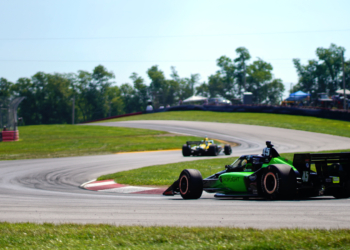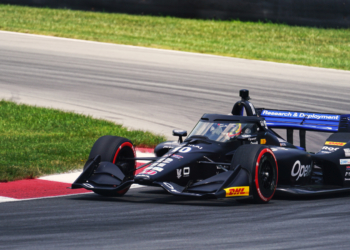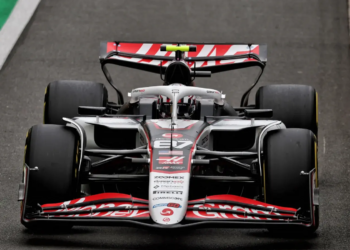This year’s Rolex 24 at Daytona has a different feel to the previous runnings. While the race has drawn plenty of big names over its six-decade history, few past grids can match the sheer volume of talent present in 2018. It’s a real “who’s who” of motorsport, with IndyCar, sportscar, Formula 1 and touring car champions all poised to share the same 3.5-mile racing surface next weekend.
In recent years, international audiences have generally viewed Sebring to be the ultimate American road race. The twelve-hours gained huge overseas popularity in the 2000s when Don Panoz and the ACO’s American Le Mans Series introduced LMP1 and LMP2 cars to that corner of Florida. While Sebring was the crown jewel of the ALMS, Daytona fabricated a big reputation of its own on the national racing scene, through its association with the Grand-Am sportscar series.

This year, however, it seems Daytona has really piqued the interest of the motor racing fan-base outside North America. The inclusion of two-time F1 World Champion Fernando Alonso in a United Autosports-entered Ligier LMP2 has whipped up a frenzy of excitement in non-sportscar circles, as have the additions of reigning DTM champion Rene Rast and a host of IndyCar champions and stars in various entries.
The top Prototype category is where the headlines will be written, and at least 15 of the 20-strong entry are realistic victory contenders. Standing back, it’s difficult to argue against this being a golden age for the IMSA championship. There are four manufacturers represented – Nissan, Mazda, Cadillac and Acura. Introduced 12 months ago, the Daytona Prototype international (DPi) regulations warmed to those household companies wanting to race at the highest level in North America, but within the global LMP2 rules that imposed a limit of four chassis makes.
Freedom was given on aerodynamic development (to give the cars a brand identity) and engine choice, but the carefully applied Balance of Performance system would keep these ‘beefed up’ LMP2s in check with the traditional prototypes from which they were born. After a teething year in 2017, when some teams took longer than others to latch onto the pace, it seems DPi (and its LMP2 parent formula) is ready to serve up some mouth-watering competition.
The manufacturers will be favourites to win, but the depth of the LMP2 customer contingent should not be underestimated. Many are former champions of the Prototype Challenge category for single-make ORECA FLM09s, which hit its expiry date at the end of last year. 2017 winner Performance Tech Motorsports has stepped up to the top class with an ORECA, while 2014 and 2015 champion CORE Autosport is running an ORECA to be driven by two Le Mans victors in Loïc Duval and Romain Dumas. BAR1 Motorsport, JDC-Miller Motorsports and PR1/Mathiasen Racing (with support from IndyCar outfit AFS) have also trodden the same path to get into the fight for overall honours.

However, the two LMP2 teams that weren’t plucked from the Prototype Challenge honour roll are perhaps the most fancied to upset the manufacturers’ applecart. United Autosports – the team co-run by Le Mans class winner Richard Dean and McLaren CEO Zak Brown – has the most famous line-up with Alonso, Lando Norris and Phil Hanson sharing a Ligier JSP217. Alonso conceded after the Roar that the team needs “to find more pace”, but it’s hard to argue against one of the world’s best racers getting stuck in against the big-name constructors.
But the fastest LMP2 crew pound-for-pound might be found in the #78 Jackie Chan DC Racing ORECA, which is fielding Mercedes factory driver Daniel Juncadella, Audi factory driver Robin Frijns, Formula E points leader Felix Rosenqvist, and Williams F1 driver Lance Stroll. Considering the Jota Sport/DC Racing tie-up’s remarkable run at Le Mans last June, there is every chance that the team can break the DPi duck and give the LMP2 formula its second IMSA series win at Daytona.
The litmus test for the Rolex 24 was the ‘Roar’ public test weekend, held a fortnight ago. Of the Prototype runners, Cadillac was the first to flex its muscles, as the DPi-V.R. package led all seven sessions. Those results were shared between the four entries from Action Express (x2), Spirit of Daytona and defending series champion Wayne Taylor Racing.
This year, the Cadillacs are running a scaled down 5.5-litre version of the original 6.2-litre ECR engine that won seven of 10 races in 2017. But even with less power, the Cadillacs still managed to top their rivals by over a second. However, that is not to say they will dominate Daytona again. A post-Roar Balance of Performance ruling was implemented to narrow the gap between top and bottom: the size of the Cadillac air restrictor was curbed, while Mazda received a 15kg weight reduction. Acura’s new ARX-05 (based on the ORECA) showed well in testing, and by the end of the weekend had eaten into some of the Caddy drivers’ times.
Nissan should be in with a shot as well, considering the Ligier-based DPi won two of last year’s final three rounds, and its parent team ESM has history at Daytona, winning two years ago. Add to that the strength in depth of the LMP2 field, this race is harder to call than the testing figures might suggest. This year’s Daytona has all the makings of a classic…
GTLM // Ford favourites after leading Roar

The Ganassi-run Fords were oozing swagger at the pre-event test, leading five of the seven sessions, plus mock qualifying. Only Porsche’s mid-engine 911 RSR managed to stop the rot at the head of the timing screens, but overall it was a convincing start from the blue oval, which is targeting its second Daytona victory in a row. Ford chose not to bring back its two-car, UK based, WEC team in 2018, meaning its effort is halved from four cars to two, but that shouldn’t take away from the Ganassi squad’s effectiveness over 24 hours. Last year’s winners Dirk Müller, Joey Hand are Sébastien Bourdais are back in the same car (expect them to be in the fight again) while Ryan Briscoe, Richard Westbrook and Scott Dixon share the sister machine.
Porsche’s chances also appeared promising after the Roar, although testing pace should always be taken with a pinch of salt. 2017 was a transitional year for the CORE-run Porsche North America concern, as it got to grips with running the new 911 RSR and having its full driver line-up delayed until the second half of the season. The complications surrounding Gianmaria Bruni’s move from great rival Ferrari meant the Italian couldn’t suit up in Porsche overalls until after Le Mans, but now he’s involved in the marque’s IMSA driving programme from the start. Bruni will drive the star-studded #912 car with ex-Audi man Laurens Vanthoor and reigning world LMP1 WEC Champion Earl Bamber. The closure of Porsche’s LMP1 racing division opened the possibility to seat Bamber and Nick Tandy (who shares with Patrick Pilet and Fred Makowiecki) back in its IMSA team.
Corvette’s form at the Roar wasn’t as notable as some of its rivals, but the C7.R should never be taken out of the equation for victory. The Pratt & Miller team has a known car, on a known circuit, with known drivers. It has retained all the familiar faces, with defending GTLM champions Antonio Garcia and Jan Magnussen teaming with Mike Rockenfeller in one car, and Oliver Gavin, Tommy Milner and Marcel Fässler in the other.

BMW is the only manufacturer introducing a new GT car this weekend. The M8 has been well received by drivers who have turned laps in private testing, but its Roar pace leaves a question mark as to where it really sits against the competition. The fastest BMW was almost half a second off the benchmark, but a weight reduction mandated by the IMSA BoP should thrust it into the heart of the inter-marque battle.
Ferrari is once again represented by the single 488 of Houston-based Risi Competizione, which has won every major sportscar race except Daytona. The team reached the podium in 2017, but its IMSA programme was curtailed by a big crash at Le Mans in the summer. This weekend marks the first 24-hour race for Risi since that incident, so durability will be one of the key objectives. Factory support from Ferrari means GT WEC champions Alessandro Pier Guidi and James Calado feature in the line-up, with fellow WEC racer Davide Rigon and works ace Toni Vilander also involved.
GT Daytona is the largest category with 21 entries, represented by eight brands and it was Lamborghini set the pace at the Roar but was kept honest by customer entries from Acura, Audi and Porsche. Lap times aside, fuel consumption is often a major factor in deciding a winner at Daytona – many fans will remember Rene Rast’s light-footed run to win for Magnus Racing Audi in 2016, beating his rivals who were battling with equally lean tanks.
Lamborghini’s #11 Huracan GT3 – the fastest car at the Roar but one of the smallest fuel capacities – lines up as one of the favourites, with 2017 Blancpain GT champion Mirko Bortolotti sharing with GT ace and former Toyota F1 tester Franck Perera, plus Rolf Ineichen and Rik Breukers. Another interesting entry is the #29 Land Motorsport Audi R8, which won two major endurance races last year. The German squad transitioned to IMSA after claiming the Nürburgring 24 crown, and went on to win the Petit Le Mans 10 hours. Land’s Christopher Mies, Jeffrey Schmid and brothers Sheldon and Kelvin Van der Linde are well-seated to add a third big trophy to the teams’ cabinet.

Other GTD entries to watch include: Manthey Racing’s #59 Porsche 911 GT3-R (featuring works assets Matteo Cairoli and Sven Müller), the #51 Spirit of Race Ferrari 488 (Aston Martin’s WEC GTE-Am champions Pedro Lamy, Paul Dalla Lama and Mathias Lauda with Le Mans GTE-Pro winner Daniel Serra) and the #58 Wright Motorsports Porsche (two-time GTD champion Christina Nielsen with quick new team-mates Patrick Long, Robert Renauer and Mathieu Jamiet).
Amongst all the favourites, US racing veteran Scott Pruett will be looking to add one final accolade to his glistening 30-year career. Pruett is hanging up his helmet after this weekend’s race in the GT3 Racing Lexus, bringing an end to a racing tenure that made him the most successful Daytona 24 driver ever (five overall wins), a multiple sportscar champion, a NASCAR podium finisher and an IndyCar race winner. His team-mates for the final swing are Jack Hawksworth, David Heinemeier Hansson and Dominik Farnbacher.






